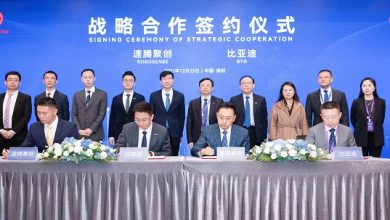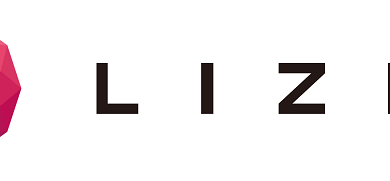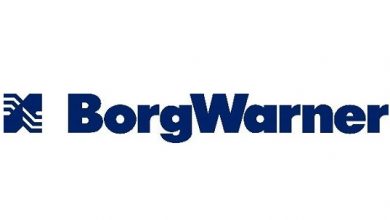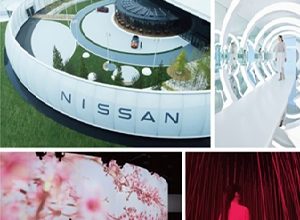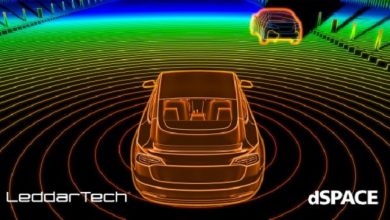Automotive LiDAR Sensors Market: Segmentation by application and geography – forecast till 2025
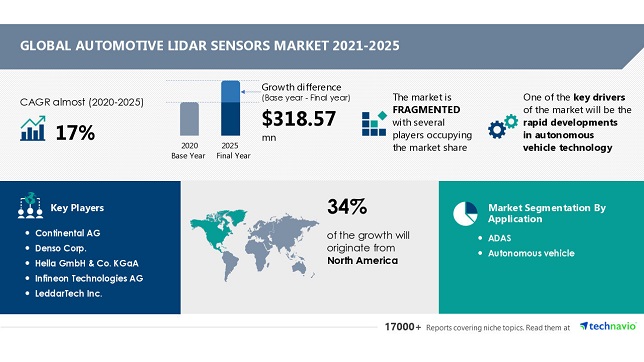
The Automotive LiDAR Sensors market is segmented into two categories based on the application (ADAS and autonomous vehicle) and geography (North America, Europe, APAC, MEA, and South America). The market share is expected to increase by USD 318.57 million from 2020 to 2025, and the market’s growth momentum will accelerate at a CAGR of almost 17%.
Parent Market Analysis
Technavio categorizes the global automotive lidar sensors market as a part of the global auto parts and equipment market within the global consumer discretionary market.
Technavio uses the total revenue generated by manufacturers to estimate the global automotive lidar sensors market size. External factors influencing the parent market’s growth potential in the coming years have been thoroughly investigated in our research analysis, to know more about the levels of growth of the automotive lidar sensors market throughout the forecast period, Download a free sample.
Automotive Lidar Sensors Market Value Chain Analysis
To maximize profit margins and evaluate business plans, an end-to-end understanding of automotive lidar sensors is required. The report will help vendors drive costs and enhance customer services during the forecast period.
- Inputs
- Inbound logistics
- Operations
- Distribution and logistics
- Marketing and sales
- Service
- Industry innovations
Vendor Insights
The automotive lidar sensors market is fragmented, and the vendors are deploying various organic and inorganic growth strategies to compete in the market. To make the best of the opportunity, the market vendors should focus more on the fast-growing segment’s growth prospect while maintaining their positions in the slow-growing segments.
We provide a detailed analysis of vendors operating in the automotive lidar sensors market, including some of the vendors such asContinental AG, Denso Corp., Hella GmbH & Co. KGaA, Infineon Technologies AG, LeddarTech Inc., Neptec Technologies Corp., Quanergy Systems Inc., Valeo SA, Velodyne LiDAR Inc., ZF Friedrichshafen AG.
Backed with competitive intelligence and benchmarking, our research reports on the automotive lidar sensors market are designed to provide entry support, customer profile, and M&As as well as go-to-market strategy support.
Product Insights and News
- Continental AG. – Offers High-Resolution 3D Flash LiDAR, which is a short-range sensor used in the automotive industry.
- Hella GmbH & Co. KGaA. – Produces iDAR, which is a new form of intelligent data collection that fuses 1,550 nanometers (nm), solid-state agile LiDAR with a low-light HD camera, and embedded AI to intelligently capture data at the sensor level.
- Neptec Technologies Corp. – Offers automotive LiDAR sensors under its trademark name OPAL 3D LiDAR.
Geographical Highlights
The automotive lidar sensors market share growth in North America will be significant during the forecast period. The US is the key market for automotive lidar sensors in North America. Market growth in this region will be slower than the growth of the market in the European, MEA, and APAC regions.
Utility vehicles such as pickup trucks, SUVs, and crossovers dominate the North American car industry. Furthermore, recreational vehicles are popular in nations like the United States and Mexico because they can be utilized for both personal and commercial purposes. Moreover, the existence of a variety of terrains, such as mountains and rugged surfaces, leads to increased vehicle sales. Also, due to the increased emphasis on improving vehicle safety, the adoption of stability control systems in SUVs, particularly mid-size and large-size cars, is high. Likewise, the market’s fierce rivalry is forcing manufacturers to differentiate their goods in terms of increased vehicle safety will drive the market during the forecasted period.
Moreover, countries like the US, Japan, Germany, China, and the UK are the key market for the automotive lidar sensors market in North America, owing to the high popularity of LiDAR sensors in automotive in this region.
Key Market Dynamics-
- Automotive Lidar Sensors Key Market Drivers:
- Rapid developments in autonomous vehicle technology
The rate of development and testing of a wide range of features in advanced driver-assistance systems and telematics/connected car applications and services will only accelerate, implying that demand for automotive LiDAR sensors will continue to rise. Consumer demands and OEM offers have expanded to encompass safety, performance, stability, and comfort, all of which are being developed and enhanced daily. This evolution has outgrown the utility of traditional mechanical components in solving developing automotive difficulties, boosting the automotive electronics market’s growth rate. Automobile electrification and an increase in the electronics content per vehicle have become unavoidable. This will increase the use of sensors in vehicles.
- Automotive Lidar Sensors Key Market Trends:
- Continuous cost reduction of LiDAR sensors
For the development of next-generation LiDAR sensors, companies are experimenting with alternative designs. The success of these designs is unknown. Only a significant reduction in the price of car LiDAR sensors is certain in the future. Various LiDAR sensor firms are focused on producing low-cost LiDAR sensors by combining all of the sensor’s components onto a single chip, with some even receiving funding from the Defense Advanced Research Projects Agency (DARPA). In today’s market, a large number of venture investors are exhibiting interest in startups that are creating better and less expensive LiDAR sensors for autonomous vehicles. It can be inferred from other automotive-related technologies, such as ABS, that LiDAR sensors would steadily get cheaper over time.

